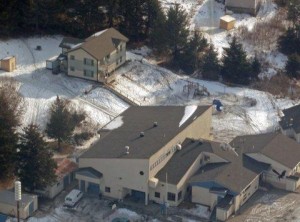
Nanwalek School is nearing 150 percent capacity, but the Kenai Peninsula Borough School district has no plan to expand the facility. It’s so crowded that next year, the principal plans to move one class into a re-purposed garage.
Nanwalek is an Alutiiq/Sugpiaq community near the Southern tip of the Kenai Peninsula.
Principal Nancy Kleine tours me through Nanwalek School where somewhere between 75 and 85 students, depending on enrollment at any given time, are packed into a building that is supposed to hold 60. She points out the room that’s the biggest problem.
“This is our secondary science and math room,” said Kleine.
The room is full with the current 21 middle school students, but over the coming years, Kleine says, the class will become even more crowded – next year and especially in two years due to an even larger projection of middle school students.
”And this is the room that is going to be a little bit too small as the population grows for our kids. Right now, it’s plenty big for the kids in here, but you can see that when you add, put 30 kids in here, it would be too small,” said Kleine.
And that’s why Kleine is re-purposing a garage.
“This was in the past…it’s been I think a shop and woodworking area. We don’t currently offer woodworking, so the district is going to purchase a conex which will go out into the corner of the property out there and all of this stuff that’s out here will go into the conex and this room will get some flooring and be a room for kids to be able to learn in,” said Kleine.
John Kvasnikoff, the First Chief of Nanwalek, says his people have been trying to get the Kenai Peninsula Borough School District to do something about their overcrowded school for a long time.
“I know we’ve been overcrowded for years and it’s like we’ve been asking what’s going to happen, you know? And they’ve never really said anything and it’s getting serious,” said Kvasnikoff.
The school was built before statehood by the Bureau of Indian affairs in 1958. There’s been no expansion at the school since an addition in 1977. But the population of Nanwalek has continued to grow. According to census data, Nanwalek’s population has nearly doubled since the state started keeping track in 1990.
Kvasnikoff, who has three children attending the school, says he believes the crowding is beginning to have a negative impact on students.
“It’s hurting our kids; they don’t have no room for them. We’ve been saying it for years. It’s…we’ve kind of been like out of site out of mind,” said Kvasnikoff.
The remote community’s concerns about crowding and requests for expansion were ignored by the District while they were flush with money, says Kvasnikoff. Now that the problem is getting worse, there are no funds due to declining oil revenue. Residents are frustrated, he says, after years of sitting on the sidelines watching other schools around the region get fancy facility upgrades.
“Look at Seldovia, they have way less kids than we do and they have this nice pool,” said Kvasnikoff.
Julie Cisco, Director of Planning and Operations for the District says Kvasnikoff is right.
“What we need to do is build or add onto. But as you mentioned and everybody’s aware, there’s no funding. And we’re not allowed to bond. The legislature took away our bonding for five years, if not more. So we don’t really have a way to do anything,” said Cisco.
According to the formula used by the State Department of Education, Cisco says the school is way over capacity.
“By the square footage calculation, Nanwalek is 138 percent over capacity right now. The building is rated for 60 students and the associated staff that goes with that. And we’re, I think, just over 80. We’re estimating it’s going to be 150 [percent capacity], this coming year,” said Cisco.
Cisco notes that in addition, the state formula does not include the high number of intensive needs students at the school, which often require an aide and additional space for learning activities.
Kvasnikoff says he believes Nanwalek will continue to grow.
“We could use a regular sized gym, more classrooms – they need more classrooms and you know they need more other stuff, not just classrooms. Keep our kids fit and we want them to participate. We’re growing and growing and w’ere going to keep growing,” said Kvasnikoff.
And, even though there’s no money right now, he wants to see an expansion plan from the district so that the problem is addressed as soon as funds become available.
Daysha Eaton is a contributor with the Alaska Public Radio Network.
Daysha Eaton holds a B.A. from Evergreen State College, and a M.A. from the University of Southern California. Daysha got her start in radio at Seattle public radio stations, KPLU and KUOW. Before coming to KBBI, she was the News Director at KYUK in Bethel. She has also worked as the Southcentral Reporter for KSKA in Anchorage.
Daysha's work has appeared on NPR's "Morning Edition" and "All Things Considered", PRI's "The World" and "National Native News". She's happy to take assignments, and to get news tips, which are best sent via email.
Daysha became a journalist because she believes in the power of storytelling. Stories connect us and they help us make sense of our world. They shed light on injustice and they comfort us in troubled times. She got into public broadcasting because it seems to fulfill the intention of the 4th Estate and to most effectively apply the freedom of the press granted to us through the Constitution. She feels that public radio has a special way of moving people emotionally through sound, taking them to remote places, introducing them to people they would not otherwise meet and compelling them to think about issues they might ordinarily overlook.




